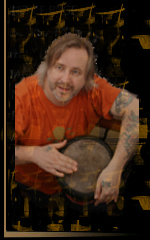|
| Interview in DRUM USA 2008 |
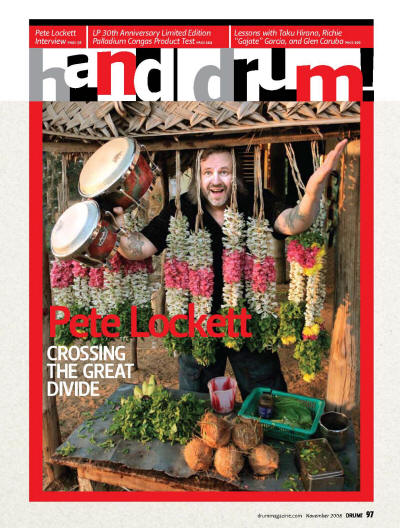
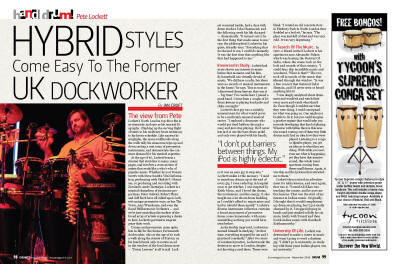
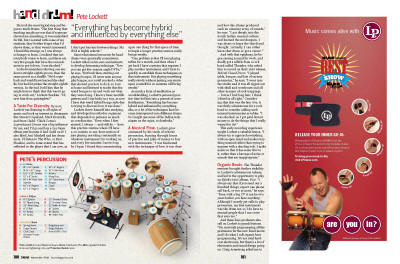
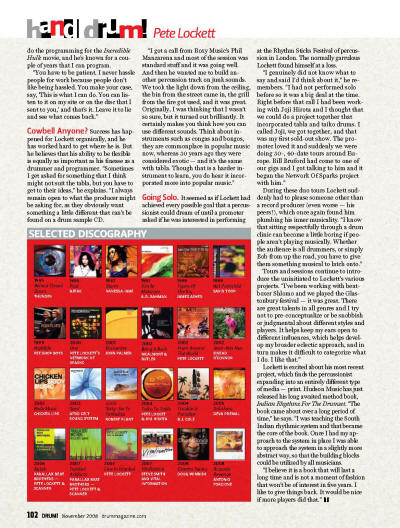
CLICK
TO DOWLOAD WHOLE ARTICLE AS PDF
Crossing The Great Divide;
Interview by: Ian Croft
Hybrid styles come easy to the former UK docker whose musical
credentials cover a dazzling array of genres
The all-encompassing view from Pete Lockett’s North London top floor
flat is as cinematic and epic as his musical CV, with the climb up the
curving flights of stairs to his flat bearing testimony to his hectic
scheduling, with the many scuff marks along the walls from numerous
trips up and down with his vast array of percussion instruments
demonstrating the constant demand for his musical expertise.
Lockett’s CV stretches to many, many pages and involves a cross section
of artists that reads like a ‘who’s who’ of popular music.
Whether he is at Ronnie Scott’s with Steve Smith’s Vital Information, or
performing with Shakti’s U Shrinivas, or producing and recording with
Zawinul’s Amit Chatterjee, Pete Lockett is a musical chameleon of
enormous proportions. Peter Gabriel, Robert Plant and Jeff Beck have all
called upon Lockett’s unique percussive ways as has The Verve, Amy
Winehouse and even the Royal Philharmonic Orchestra – and we’re just
scratching the surface here of the broad array of artists expressing a
desire to have Lockett’s percussive imprint grace their work.
Drums and percussion came quite late in life for the former Portsmouth
docker, who at the age of 19 and on his lunch-break took a walk along
the streets of Fratton only to notice an ad in the window of the local
drum store. ‘Drum Lessons’ is all it said. Lockett ventured inside, had
a chat with drum teacher John Hammond and the following week his life
changed – dramatically. “It turned out to the first thing that made
sense to me” says the philosophical Lockett in his quiet friendly tone.
“John was pleasantly surprised too, as everything that he showed to me,
I could do instantly. It was the first time that anything like that had
happened to me. At school, nothing interested me at all, not even music
lessons.”
Since that encounter with Hammond, Lockett has recorded percussion on
the last four Bond movies, currently working on the fifth, performed
around the globe with a dazzling array of musicians and established
himself as one of the ‘first-call’ players in the UK. Lockett has just
released his tuition book on Hudson Music, Indian Rhythms For The
Drumset, a unique approach to playing Indian rhythms – well, on the
drums.
Immersed In Study
Lockett had never shown any interest in music before encountering that
advert and his family household was without music, although “We did have
a radio, but there were no records or musical instruments in the house.
But, as soon as I discovered drum lessons, that was it - big time! Two
weeks later I joined a punk band. I went from a couple of £5 drum
lessons to playing local pubs and clubs overnight.”
Lockett’s first gig was just the start of his unusual musical journey.
“I replaced a drummer who would get tired halfway through a song and
just stop playing. He’d never learnt to use the bass drum pedal and only
ever played with his hands, so it was an easy gig to step into”. Lockett
smiles at the memory. “I used to smash my drums up at the end of every
gig. I even ended up in hospital once to get stitches. I was inspired by
Keith Moon and I loved the drums, the excitement and the energy. It also
taught me a lot about drum building as I couldn’t afford to get mine
repaired and had to rebuild them myself.” Lockett’s diverse instrument
store is testimony to his broad collection of percussive items, some
home made, with many resembling nothing that you would have seen before.
Lockett immersed himself in total study claiming; “At that time
everything stopped for me and I practiced constantly.”
After two years of continual practice, Lockett took the decision to move
to London, despite not knowing a soul there. Times were bleak.
“I rented an old concrete store in Finsbury Park in North London, that
doubled as a bed-sit and the place was just full of dust and was very
cold. It was very depressing.” He recalls with a chill.
In Search of the Music
The London move found Lockett playing kit in Punk and Rock bands. The
Punk era had given way to New Wave and mid 80s London was awash with
bands and gigs. By chance, a friend invited him to his apartment
situated near Alexander Palace, a venue that hosted the Festival of
India where the venue took on the look and sounds of that country. "I
could hear this incredible music and wondered what is that?" The two
took off in search of the music that filtered through the window
following it to its source. "It was a free concert that featured Zakir
Hussain and I'd never seen, or heard anything like it! I was deeply
analytical about drummers and would sit and watch their every move and
watch what they'd do. Even though I couldn't see what they were doing, I
could conceptualize what was going on. One might not be able to do it,
but you could imagine a practice regime that would take you towards
developing that kind of playing. Whereas, with tablas, there is this
massive sound coming out of these tiny little drums and I had no idea
how they were played. Listening to a conga or djembe player, you get an
idea as to what they are doing. With tabla you can't even see what is
happening yet they have this massive sound, this whole tonal spectrum
coming from these small drums. Again, it was this and the lyricism that
attracted me to them.”
Lockett then noticed an advert for tabla lessons and again, that was it!
“Yousuf Ali Khan” was teaching the course and he gave me free lessons
and that was the start of my interest in Indian music. Originally, I
thought that it would compliment my drum-set playing, but I got totally
obsessed by it. I stopped playing in bands and just studied solidly for
six years, firstly with Yousuf and then South Indian music with
“Karakudi Krishnamurthy”.
University of Life
Adamant that he was going to make a career out of music and that he
wasn't going to work a daytime gig Lockett adds "I didn't go to
university, so studying with these great Indian players was my
university”.
Pete also began teaching drums saying; “The first thing that teaching
taught me was that if someone showed me something, it was embedded for
life, but I noticed with some of my students, they'd either forget what
I'd shown them, or they weren't interested. I found this strange, as I
was always so hungry to learn. I realized that not everybody wants to
learn and there are very few people that have the commitment to get it
down - I was shocked.”
Lockett showed one student a straight eighth groove, then the same
groove as a shuffle. “He'd come back and would have learnt the shuffle,
but had forgotten the straight eighth version. In the end I told him
that he might have to think that this wasn't going to work out. I'd save
him from quintuplets!” Lockett chuckles.
Eclectic iPod
By now, Lockett was listening to music across the board and took an
interest in players like Stewart Copeland and Mark Brzezicki, both being
big favorites, as was Steve Gadd. “Chick Corea’s Leprechaun's Dream was
a big influence for me and I'd go and buy a Leo Sayer album just because
it had Gadd on it and you didn't get too many of my friends buy Leo
Sayer albums! I also liked Joni Mitchell and her drummers. I'd listen to
The Who, or Ravi Shankar and to some extent that has reflected in the
player that I am now, as I don't put barriers between things. My iPod is
highly eclectic.”
Back at that time musical education was dramatically different to today.
"Now you can get five-camera angle DVD's, but back then, starting out
playing bongos, I'd never seen anyone play bongos nor could you find a
video that showed you how to do it, so I sat at home and listened to
tracks that featured bongos to try and work out what they were doing and
what was going on. I knew a basic martillo pattern and I was lucky in a
way, as now I have this weird hybrid bongo style due to trying to
discover how it was done.”
Lockett’s study continued. “Even when I first started I always and still
do have this practice routine where I'll have a 30 minute or one hour
session of just playing one thing continually on whatever instrument I'm
working on and every five minutes I move it up by 5bpm. I found that
concentrating upon one thing for that space of time to begin a longer
practice session really brings results.” Continuing, “One problem is
that I'll tour playing tablas for a month and then when I get back I
have a session that requires I play another instrument and I have to
quickly reestablish those techniques on that instrument. But, playing
something really slowly without putting any strain upon yourself for 30
minutes will bring results.” Pete will also cross-fertilize styles,
adding; “Everything has become hybrid and influenced by everything else
so a lot of the techniques have become interspersed onto different
drums, so I might use some of the Indian techniques on the cajon, or
Darabuka.”
A Musical Flow
At a time when the term 'World Music' was in its infancy in the UK it
was not an easy task for Lockett to gain access to the wealth of
material that he so desperately sought.
"I was fascinated with the technique of how it was done and how the
drums produced such an amazing array of sounds.” Lockett concentrated on
learning the many compositional styles and syllables that apply to the
sounds of the strokes and notes making his study all encompassing. “It
was a great way of learning as there was this whole cycle of things that
you go through and memorize. I got deeply into the South Indian musical
culture and learnt the Mridangam and was about to learn the Thavil and
thought, actually, I can either learn that drum or get a career.” And
with that thought Lockett started contacting people, sending them his
CV. Lockett’s first session was for the rock band Thunder. “I got a call
out of the blue to record with them and played tabla, bongos and lots of
various percussion. I went into the studio and it was all rigged out
with skull and cross bones and all other manner of 'rock' trappings, but
as I had long hair, I think I fitted in alright.” he adds. Considering
that this was the late 80s, it was fairly adventurous of Thunder to
consider adding such eclectic instruments as Tablas. "I was shocked as I
got paid decent money to do the things that I really wanted to do!”
The recording experience taught Lockett a valuable lesson. “I always try
and approach everything with an open mind and make everything musical
rather than trying to impress with a dazzling solo. I make music so that
it has some flow to it, rather than a barrage of noise or sounds that
are inappropriate”. Lockett states emphatically.
Organic Beats
The Thunder sessions brought further visibility to Lockett’s adventurous
percussive outings.
“I started to get different things and worked on Bjork's Post record
which was a more Latin flavored session, but I wouldn't call myself a
Latin player, I can play outside of the idiom with that kind of music. I
felt I had put a lot of effort in and I always say that if you send out
a hundred things, expect one phone call, or two at most back. Even with
a big CV it can be two years before you hear anything. Although I mostly
get calls to play percussion my first instrument was the drum set so I
do have to remind people that I can cover that area too”. It’s not just
his inventive playing that Lockett gets called for either. “I'm
currently programming all the percussion for the new Bond movie and I do
what I call organic beat programming, it's not total hardcore
electronics, but there's a lot of electronics and sound design going on.
Craig Armstrong asked me to do the programming for the Incredible Hulk
movie and he's known for a couple of years that I can programme. You
have to be patient. I never hassle people for work because people don't
like being hassled. You make your case, say this is what I can do, you
can listen to it on my site or on the disc that I sent to you and that's
it, leave it to lie and see what comes back.” Lockett genuinely advises.
Cowbell Anyone?
It has ‘happened’ for Pete organically and he has worked hard to get
where he is. “People like to see that your active and I currently have
eight albums out and four more coming out in India this year. Of course
you’ve got to be able to play or no one will call you. You have to get
on with people or the work will quickly dry up. Sometimes, I get asked
for something that I might think might not suit the tabla, but you have
to get to their ideas and I always remain open to what the producer
might be asking for as they obviously want something a little different
that can’t be found on a drum sample CD. I got a call from Roxy Music’s
Phil Manzarena and most of the session was standard stuff and it was
going well and then he wanted me to build a another percussion track on
junk sounds. We took the light down from the ceiling, the bin from the
street came in, the grill from the fire got used and it was great.
Originally, I was thinking that I wasn’t so sure, but it turned out
brilliantly. It opens your mind up for the drums because if you consider
the history of the drum set, there were a lot of percussion instruments
included in the set. Now, it’s just become hardcore drums and a lot of
people wouldn’t even think as far as a cowbell or wood block and how
they could incorporate those sounds.” Lockett states almost
despairingly.
Having an open mind is what has set Lockett on his course of discovery.
“It certainly makes you think how you can use different sounds. Think
about instruments such as congas and bongos, they are commonplace in
popular music now, whereas thirty years ago they were considered exotic
and it’s the same with tabla. Though, that is a harder instrument to
learn, you do hear it incorporated more into popular music.”
Think Musically
It’s not just calls to add some exotic spice to recordings that employs
Lockett’s time. It seems that as fast as he works on one project,
artists involved within that project result in another project being
born.
“Again, that’s something that came to me. I accompanied some artists in
Sardinia for a promoter and it went well and the promoter then advised
on artists for the Rhythm Sticks Festival in London. He asked if I
wanted to play the festival and I genuinely did not know what to say and
said I’d think about it. I had not performed solo before so it was a big
deal at the time. Right before that call I had been working with Joji
Hirota and I thought that we could do a project together that
incorporated Tabla and Taiko drums. I called Joji, we got together and
that was my first sold-out show. The promoter loved it and suddenly we
were doing 30-40 date tours around Europe. Bill Bruford had come to one
of our gigs and I got talking to him and it began the Network of Sparks
project with him.”
It was during these ‘duo’ tours that Lockett had to perform solo spots
that again, made him think musically about what he was doing.
“I know that sitting – respectfully, through a drum clinic, can become a
little boring if people aren’t playing musically. Whether the audience
is all drummers, or simply ‘Bob’ from up the road, you have to give them
something musical to latch onto.”
Tours and sessions continued to introduce musicians to Lockett’s various
projects. “I’ve been working with beat boxer Shlomo and we played the
Glastonbury festival and it was great. There are great talents in all
genres and I try not to pre-conceptualize or be snobbish or judgmental
about different styles and players. It helps keep my ears open to
different influences which helps develop my broader eclectic approach
which in turn makes it difficult to categorize what I do. I like that”
Breaking Down The Barriers
Lockett’s genuine love, respect and dedication for so many different
influences opened many doors for him over recent years, saying;
“Barriers are being broken down and I’ve now found that I am welcomed
and accepted in India at the highest level. In India to collaborate
successfully you do have to know their musical formalities and the
particular ways they work. You are often thrown into gigs without any
rehearsal or sound check and everything is a manic bpm, so that’s the
first thing that you have to get used to and it’s not unusual to play a
two or three hour gig. Even with minimal sound checks, you really need
to think about getting your monitoring correct so that you can hear
everything clearly as they often play on the front edge of the beat.
Technically you have to have real control over what you are doing and
keep it buoyant but without speeding up. It’s like fast be-bop and very
hard to control.”
The Book
I like to give things back. It would be nice if more players did that.
The free lessons on my site are my answer to this. They cover everything
from the basics of bongos to cajon lessons to drum set playing and of
course a lot of the Indian rhythmic systems. The book came about over a
long period of time as I’d been trying to apply the Indian knowledge to
the drum set and it took me many years to do that, to find ways of
articulating those rhythms onto the drum set. Slowly it came about
through other percussion instruments as everything become ‘one’ and
stopped being separate instruments in my mind and I began to think of
them as a family of instruments which is why I call myself a
multi-percussionist. I was teaching the South Indian rhythmic system and
that became the core of the book. Once I had my approach to the system
in place I was able to approach the system in a slightly more abstract
way so that the building blocks could be utilized by all musicians. I
give people the building blocks and would then move on to whole
compositions. I got a lot of positive feedback from students using this
method. They could understand and perceive the building blocks and then
see how they were built into the larger compositions and themes.
The next logical step was to articulate it onto the drums. Really, the
book gives you two things, there is the system that can be for everyone
and then there is the application for the drum set. The book contains
the South Indian syllables / building blocks and the rhythmic structures
and then the applications for anybody to use. I wanted to model the book
on the book that covered African drumming on the drum set where the
first big chunk is the history, the drums, the idiomatic setting and
then the extrapolations on the drum set. I believe it is a book that
will last a long time and is not a moment of fashion that won’t be of
interest in five years. The whole development of the book came from the
education method so it is kind of organic in that way. It never started
out to be a book, but it ended up being one!
www.hudsonmusic.com
RETURN TO INTERVIEWS /
PRESS MAIN PAGE


|

